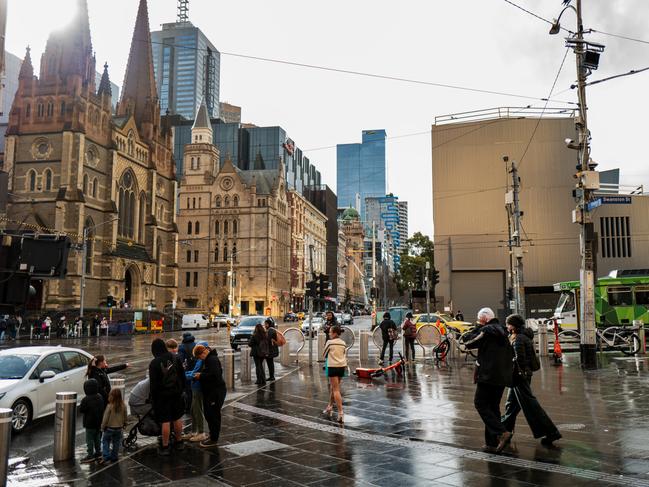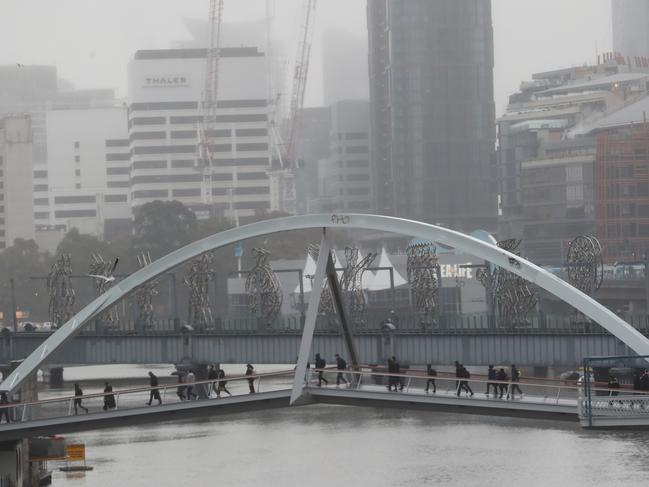Melbourne weather to soar to ‘unusually high’ maximum temperatures in spring
Melbourne’s long and tedious winter will soon be in the rearview and with higher than usual temperatures forecast for the coming weeks, spring weather is looking bright.

Victoria
Don't miss out on the headlines from Victoria. Followed categories will be added to My News.
Bid farewell to winter, as a beautifully warm start to spring is on the way.
Melbourne has an 80 per cent chance of seeing hotter than usual temperatures next week with maximums soaring to about 18 degrees, according to the Australian Bureau of Meteorology.
The state is also in for a chance at breaking winter and August records with its spout of sun.
September is looking mighty warm and sunny too, with temperatures also 80 per cent likely to be above average for all of Australia.
For the city, that means a high chance of maximums surpassing 17 degrees on the regular.
“There is an increased chance of unusually high maximum temperatures (in the warmest 20 per cent of years) for almost all of Australia, particularly across the north,” A Bureau of Meteorology spokesman said.
“The risk of heatwaves increases as we approach the warmer months.
“Forecast maximum and minimum temperatures will be 8 to 12 degrees above average for several days, with up to 16 degrees above average in some parts of central Australia.”

Four reasons Melbourne’s winter weather felt ‘off’
If there’s one thing you can count on in Melbourne, it’s the rollercoaster weather.
But if you feel like the temperatures have been even more fickle than usual this season, it’s not your imagination.
From record-breaking warmth to a string of dismal grey skies, here are four reasons why the climate in the city has been particularly abnormal this winter.
1. Hardly any sunshine
The city barely saw the sun at all in the first two months of winter.
Melbourne suffered through a whopping 60-hour decrease in hours of sunshine for the first two months of winter compared to last year.

Not only that, the city recorded a 23-year low in sunshine seen in July, with just a dismal 3.4 hours of sunshine on average each day recorded at the Melbourne Airport weather station.
The same time last year, the city saw five hours of sun each day.
June also had record-low sunshine levels, recording an average of 3.5 hours each day – the lowest levels since 2014.
2. Rainfall has been all over the place
If this doesn’t scream Melbourne, what does?
Melbourne first saw its driest June since 2006 this year, with just 12.2mm of rain recorded.
But then came July, and it was a different record being broken – the city was hit with 58.2mm of rain, the most recorded since 2016.

3. Record-low temperatures
Melbourne – you can officially say you survived one of the coldest starts to winter this vicennial.
Average minimum temperatures in June dropped to 5.4 degrees. Only twice since 2000 has the month of June ever been colder – 2018 and 2006.

The average maximum temperature in June was also dismal at 13.5 degrees – the coldest recorded this decade.
July was also mighty chilly, with the average maximum temperature just 13 degrees.
Our warmest ever average July maximum was recorded last year at 14.8 degrees.
Melbourne saw low pressure systems in the Tasman Sea directing cold air and cloud, but little rain, onto Melbourne, a Bureau spokesman explained.
4. August doesn’t feel like winter at all
Just as Melburnians were accepting the staggering low temperatures and dreary skies came a sunny August.
It seems to have forgotten it’s still winter, delivering its warmest maximum temperatures dating back 25 years.

The city has also enjoyed above-average rates of sunshine in the first three weeks at about six hours each day.
And while August usually delivers about 40mm of rain, Melburnians have not needed their umbrellas, with a total 8.2mm of rainfall over 22 days.
Those minimum temperatures have also been sky high, at an average of 6.8 degrees, one of the top-four warmest Augusts we’ve had since 2000.



